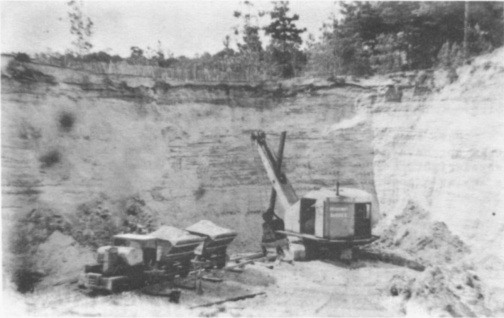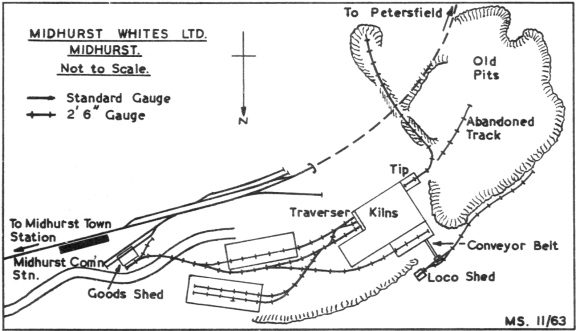
| THE INDUSTRIAL RAILWAY RECORD |
© DECEMBER 1964 |
MIDHURST WHITES
by C. G. DOWN
In a ‘Wild West" atmosphere of sand and pine trees Midhurst Whites carry on their activities of making whiter-than-white bricks. Their works, situated by the long-closed Midhurst Common station on the truncated remains of the LSWR Midhurst to Petersfield line, operates a 2' 6" gauge rail system on three levels - lower, where the final products are marshalled; middle, where sand is excavated; and upper, where the disused pit is reclaimed.
When the LSWR track was lifted the firm decided to extend the middle level and, by means of a cutting and an embankment, crossed over the LSWR trackbed to open up a new pit. This new line is about 300 yards long and was constructed from materials from the abandoned lime in the old pit. It is virtually level except for the last few yards to the working face where it drops sharply. A rail-built buffer stop has been erected here. The rail is flat-bottomed, about 50 lbs. per yard, and spiked direct to ex−B.R. sleepers; it gives a fairly smooth ride.
This centre line is worked by a 4−wheel Simplex diesel locomotive (works number 8981) and two skips, bringing back about four tons of sand each Journey. The sand is tipped at the western end of the works and, after washing, is nixed with cement and moulded in the pressing sheds. The bricks pass to the lowest level of the works where they are fired.

A Simplex loads up at the quarry face on 25th July 1963. (S. N. G. Down)
The waste from the manufacture is passed via a conveyor belt to the upper line where it is fed into a half-dozen skips. Two of the latter have inside frames and the rest outside. The 4−wheel Simplex petrol locomotive (no. 6035) which works here is housed in a small corrugated iron shed at one end of the line. It propels two skips at a time along about 200 yards of temporary track around the lip of the disused pit where the spoil is tipped.
Returning to the lowest level, there is quite a complex arrangement of prefabricated track which serves the two storage sheds. There are a large number of well-sprung flat wagons, which are more broad than they are long. Newly made bricks are taken on these from the kilns, via a traverser, to the sheds for storage or loading on to lorries. A now disused branch runs between the two storage sheds, through the bushes, across the road and down to the also disused LSWR goods shed. Here, in the good old days, the bricks were transferred for rail shipment.

Two locomotives work on the lowest level. The largest, and more commonly used, is an unusual 4−wheel Hudson petrol whose outside frames reach almost to the ground. It tows wagons around by means of a chain which keeps the wagons at a distance as though silage, not bricks, was their load. The other locomotive on this level is another 4−wheel Simplex petrol, No.6023.
All four locomotives are painted grey; the Simplexes have wooden cabs but the Hudson has a canopy only. heavy repairs are done during the firm‘s annual holidays in August. The locomotives work reliably and, despite their drab livery, add greatly to the coniferous forest which alone makes a visit to the works well worth while.